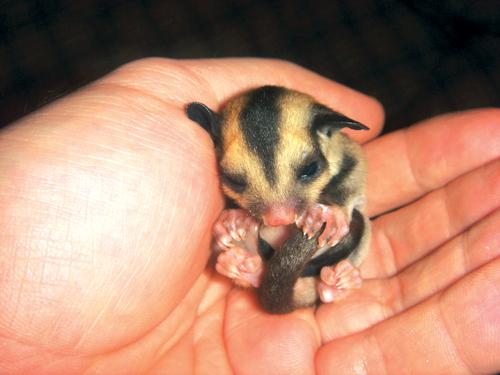Phuket Pets: As sweet as sugar

PHUKET: When browsing through markets in Thailand, it is always fascinating to come across a pet store and see which exotic animals they have on offer. Snakes, lizards, turtles, hedgehogs and even African cennec foxes can be found among the more usual cats and dogs.
Walking through the Phuket Town weekend market recently, I discovered a pet shop selling sugar gliders, and was delighted to get a closer look at these tiny marsupials.
Sugar gliders take their name from their predilection for sweet saps and sugary fruits and their ability to glide up to 50 meters using a skin membrane that stretches between their legs. It’s hard not to instantly impulse-buy one of these cute, furry, doe-eyed little critters, which are native to my own country Australia, but rarely kept as pets there.
If you have ever considered buying a sugar glider to keep as a pet, there are a few things to consider before you leap in head first. Despite looking quite similar in size and shape to domesticated rodents such as guinea pigs, hamsters and mice, sugar gliders have quite different feeding and care needs, and are rightly referred to as an ‘exotic’ pet.
Sugar gliders, like their more famous cousins kangaroos and koalas are marsupials, meaning that they carry their young in a pouch. They are also nocturnal, so in their natural environment they sleep during the day and hunt and feed at night. Furthermore, they are omnivores, feeding on a variety of foods including fruit, insects and even tree sap. As you can see, these traits make sugar gliders quite different from your average hamster and therefore some consideration is needed to providing the correct diet and cage for your sugar gliders to thrive.
Where to keep them?
Due to there natural proclivity to jump and fly from tree to tree, sugar gliders prefer a large cage or even an aviary style cage with small wire mesh for climbing. You should provide plenty of platforms and branches at different levels of the cage so they can move around freely. Be sure to buy a good exercise wheel for them to play on.
Sugar gliders mark their territory with scent glands and have been know to get quite smelly if their cage is not regularly cleaned. They can be kept inside and allowed to roam outside of their cage for exercise and to play with their owner. You could also consider a larger outdoor cage to enable them more freedom and to ensure more peace and quiet for yourself; being nocturnal, they can be quite noisy at night.
What to feed them?
The key to keeping your sugar glider healthy and happy is variety. As a general rule, you should feed them 50 per cent insects and a 50 per cent mix of fruit and vegetables. They eat all types of insects and – this being Thailand – you could always ensure a fresh supply by talking to a fried insect snack vendor at your local market! Many people feed them on meal worms and other easily obtainable grubs and larvae. Make sure you feed them a wide variety of fruit and vegetables in order to give them a balanced diet with all the necessary vitamins and minerals.
How to care for them?
Sugar gliders are very social animals and it is unwise to get only one. At the bare minimum, buy a pair, but try to ensure they are of the same sex or you might end up with more critters than you bargained for. With the proper care, love, and attention, the sugar glider will bond with you. It is best to buy your gliders quite young, and to begin the bonding process as soon as you can. A sugar glider that is well bonded to its owner will often snuggle up to its owner’s chin while making happy little clicking sounds, climb inside a pocket and fall asleep in a little ball and enjoy being hand fed.
Despite requiring some effort to take care of properly, they are a wonderful treasure for those with a little patience and understanding, and a fun way for children to learn about taking care of animals.
For more information about sugar gliders as pets see: https://littlefurrypets.com/.
Keep checking our Phuket Lifestyle pages for the latest features from across the island. Join our Facebook fan page or follow us at @PhuketGazette.
— Mark Knowles
Latest Thailand News
Follow The Thaiger on Google News:


























